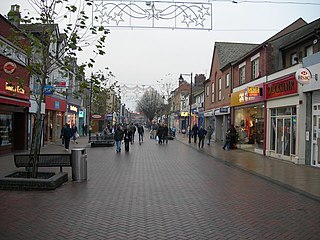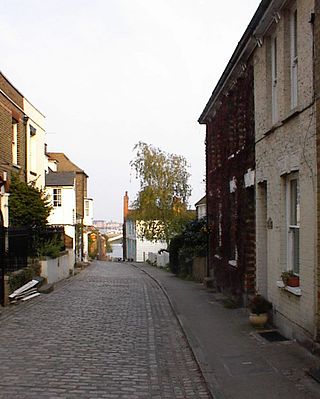Related Research Articles

Chatham is a town located within the Medway unitary authority in the ceremonial county of Kent, England. The town forms a conurbation with neighbouring towns Gillingham, Rochester, Strood and Rainham. In 2020 it had a population of 80,596.

Rochester is a town in the unitary authority of Medway, in Kent, England. It is at the lowest bridging point of the River Medway, about 30 miles (50 km) from London. The town forms a conurbation with neighbouring towns Chatham, Rainham, Strood and Gillingham. Rochester was a city until losing its status as one in 1998 following the forming of Medway and failing to protect its status as a city. There have been ongoing campaigns to reinstate the city status for Rochester. In 2011 it had a population of 62,982.

Medway is a local government district with borough status in the ceremonial county of Kent, South East England. Its council, Medway Council, is a unitary authority, being a district council which also performs the functions of a county council; it is independent from Kent County Council. The borough had a population of 278,016 in 2019. It was formed in 1998 by merging the boroughs of Rochester-upon-Medway and Gillingham. The borough contains the towns of Chatham, Gillingham, Rainham, Rochester and Strood, which are collectively known as the Medway Towns.

Gillingham is a town in the unitary authority area of Medway, in the ceremonial county of Kent, England. The town forms a conurbation with neighbouring towns Chatham, Rochester, Strood and Rainham. It is also the largest town in the borough of Medway. In 2020 it had a population of 108,785.

Gravesham is a local government district with borough status in north-west Kent, England. The council is based in its largest town of Gravesend. The borough is indirectly named after Gravesend, using the form of the town's name as it appeared in the Domesday Book of 1086. The district also contains Northfleet and a number of villages and surrounding rural areas.

Rainham is a town in the unitary authority area of Medway, in the ceremonial county of Kent, England. The town forms a conurbation with neighbouring towns Chatham, Rochester, Strood and Gillingham.

Strood is a town in the unitary authority of Medway in Kent, South East England. The town forms a conurbation with neighbouring towns Chatham, Rochester, Gillingham and Rainham. It lies on the northwest bank of the River Medway at its lowest bridging point.

Lower Upnor and Upper Upnor are two small villages in Medway, Kent, England. They are in the parish of Frindsbury Extra on the western bank of the River Medway. Today the two villages are mainly residential and a centre for small craft moored on the river, but Upnor Castle is a preserved monument, part of the river defences from the sixteenth century.

Medway was a county constituency represented in the House of Commons of the Parliament of the United Kingdom between 1983 and 2010. A previous constituency of the same name existed from 1885 to 1918.
Strood Rural District was a rural district in the county of Kent, England.

Rochester and Strood is a constituency in Kent represented in the House of Commons of the UK Parliament since 2024 by Lauren Edwards from the Labour Party. It was previously represented since 2015 by Kelly Tolhurst, a Conservative, who had served as Government Deputy Chief Whip and Treasurer of the Household since 2022.

Rochester-upon-Medway was a local government district in north Kent, England from 1974 to 1998. It covered Rochester, Chatham, Luton, Lordswood, Walderslade, Strood and the Hoo Peninsula.

The County Borough of Leeds, and its predecessor, the Municipal Borough of Leeds, was a local government district in the West Riding of Yorkshire, England, from 1835 to 1974. Its origin was the ancient borough of Leeds, which was reformed by the Municipal Corporations Act 1835. In 1889, when West Riding County Council was formed, Leeds became a county borough outside the administrative county of the West Riding; and in 1893 the borough gained city status. The borough was extended a number of times, expanding from 21,593 acres (8,738 ha) in 1911 to 40,612 acres (16,435 ha) in 1961; adding in stages the former area of Roundhay, Seacroft, Shadwell and Middleton parishes and gaining other parts of adjacent districts. In 1971 Leeds was the fifth largest county borough by population in England. The county borough was abolished in 1974 and replaced with the larger City of Leeds, a metropolitan district of West Yorkshire.

Frindsbury is part of the Medway Towns conurbation in Kent, southern England. It lies on the opposite side of the River Medway to Rochester, and at various times in its history has been considered fully or partially part of the City of Rochester. Frindsbury today is part of the town of Strood and covers the most northern part of the town. Frindsbury refers to both a parish and a manor. Within the civil parish of Frindsbury Extra are the villages of Frindsbury, Wainscott, and Upnor. Frindsbury was also the name given to an electoral ward in the City of Rochester that straddled the parishes of Frindsbury and Strood.

Frindsbury Extra is a civil parish divided into commercial, suburban residential and rural parts on the Hoo Peninsula in Medway, a ceremonial part of Kent. It is contiguous with the fully urbanised Frindsbury part of Strood and is bounded by Cliffe and Cliffe Woods to the north, Hoo to the east, and the River Medway to the south-east at Upnor and a long, narrow meander of the river in the far south. On Medway Council it has councillors representing the Strood Rural ward currently on almost identical boundaries.
Frindsbury TQ744697 51°23′58″N0°30′29″E is a parish on the River Medway, on the opposite bank to Chatham Dockyard in Kent, England. It was a centre of ship building before 1820, building at least six 74 gun third rate ships of the line and many smaller vessels. From 1820, until recent times, the ship yards built over 100 Thames sailing barges. Shipbuilding has stopped but in 2006, one yard was still active in ship repair.

Medway Council is the local authority of Medway, a local government district in the ceremonial county of Kent, England. The council is a unitary authority, being a district council which also performs the functions of a county council; it is independent from Kent County Council. The council was created on 1 April 1998 and replaced Rochester-upon-Medway City Council and Gillingham Borough Council.

All Saints, Frindsbury, is a parish church serving the combined parish of Frindsbury with Upnor and Chattenden. The church dates from 1075 and lies in the north-west corner of the Medway Towns, historically part of Kent, England. It is a Grade II* listed building, National Heritage List number 1107886.
References
- 1 2 Youngs, Frederic A Jr. (1979). Guide to the Local Administrative Units of England. Vol. I, Southern England. London: Royal Historical Society. pp. 638–640. ISBN 0-901050-67-9.